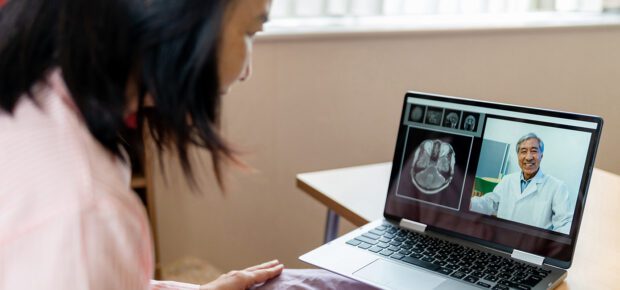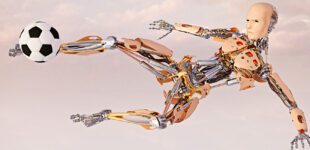May 27, 2022
A rising population of elderly patients. A shortage of doctors. Limits on in-person visits with health care providers.
These trends are driving healthcare to a fourth industrial revolution, what IEEE member Eros Pasero, a professor at Politecnico of Turin, calls “Medicine 4.0.” Previous revolutions in medicine, in his view, include discovery of DNA’s double helix structure, the sequencing of the human genome to help understand the origins of disease and the convergence of biology and engineering to develop medical devices.
The ideas behind this new paradigm in health sciences are the subject of Pasero’s lecture “Medicine 4.0: When New Technologies Work with AI,” which he offered as part of the Fall 2021 IEEE Instrumentation and Measurement Society Virtual Distinguished Lecturer Series.
It’s a discussion that weaves together the newest frontiers in telemedicine, artificial intelligence, medical devices and connectivity to present a new vision of healthcare.
What are the demographic drivers of telemedicine?
After World War II, increasing economic well-being led to a baby boom, which today has resulted in a huge increase in the number of elderly people. Doctors now treat more complex diseases in a population with longer life expectancy, and the number of doctors hasn’t risen. Telemedicine is the only way to allow doctors to manage these large numbers of patients.
How do those demographic drivers impact the design of medical devices?
Limited financial resources limit the number of doctors available to care for the elderly. Remote medical devices can help monitor multiple patients remotely without increasing the number of doctors. Additionally, the use of these simple medical devices can overcome limits on patient visits through COVID.
Your lecture touched on the idea of Medicine 4.0. What is it? And how does it differ from Medicine 3.0?
One of the possible applications of industry 4.0 is a new healthcare model. Medicine 3.0 represented the moment of the transformation of the way of operating through the introduction of technology in the work process. Medicine 4.0, through digitalization, can create virtual copies of the patient and use machine learning to reduce the possibility of error to zero, and also reduce costs and improve the quality of the service.
What are some of the advantages of integrating neural networks and artificial intelligence into remote medical devices and wearables?
Blood pressure is a great example. The gold standard in blood pressure measurement is extremely invasive, and is usually only done on patients that are in the ICU. It measures arterial pressure from inside the artery. Most of us are familiar with the blood pressure cuff, which is pretty good, but not quite as precise as the gold standard and requires a health care professional to operate. And then there is the automatic cuff, which has some other shortcomings: it’s not so precise, and it’s subject to users simply putting their arm in the wrong way.
But, with an AI database, we can build a model of blood pressure using other variables associated with the beating of the heart, like pulse wave velocity and pulse transit time. When these factors are measured with a wearable device similar to a fitness tracker, our model was slightly more precise than a blood pressure cuff. And, the patient could take the measurement on their own.
Remote medical devices are important for monitoring remote patients. Artificial intelligence and neural networks make it possible to make predictions about the patient’s status in the future. AI can also be used to understand a patient’s particular vital signs.
What are some of the challenges of using AI and neural networks in remote medical devices?
One challenge can certainly be to replace certain functions of the doctor using AI. Remote diagnosis of some simple diseases can be done using AI, giving doctors more time to check for complex diseases.
What’s the research agenda for technologists working in this space? What big problems need to be solved next?
Digital health needs AI. Today 19% of healthcare leaders are prioritizing investments in AI but 37% plan to do so over the next three years. But there are several obstacles to the digital transformation of the sector. There is a need to overcome the lack of technology experience among staff, the challenges of governance, interoperability and data security.
From a scientific point of view, the tools of AI should be evaluated: reliability, precision, accuracy and other parameters must be validated by regulatory agencies.
You can learn more about the ideas behind Medicine 4.0 by watching Prof. Pasero’s full lecture through the IEEE Instrumentation and Measurement Society.






 Meaningful Momentum or Running in Place?
Meaningful Momentum or Running in Place? AI Through Our Ages
AI Through Our Ages Liquid Infrastructure: Our Planet's Most Precious Resource
Liquid Infrastructure: Our Planet's Most Precious Resource The Impact of Technology in 2025
The Impact of Technology in 2025 Quantum and AI: Safeguards or Threats to Cybersecurity?
Quantum and AI: Safeguards or Threats to Cybersecurity? Why AI Can't Live Without Us
Why AI Can't Live Without Us Bits, Bytes, Buildings and Bridges: Digital-Driven Infrastructure
Bits, Bytes, Buildings and Bridges: Digital-Driven Infrastructure Impact of Technology in 2024
Impact of Technology in 2024 Emerging AI Cybersecurity Challenges and Solutions
Emerging AI Cybersecurity Challenges and Solutions The Skies are Unlimited
The Skies are Unlimited Smart Cities 2030: How Tech is Reshaping Urbanscapes
Smart Cities 2030: How Tech is Reshaping Urbanscapes Impact of Technology 2023
Impact of Technology 2023 Cybersecurity for Life-Changing Innovations
Cybersecurity for Life-Changing Innovations Smarter Wearables Healthier Life
Smarter Wearables Healthier Life Infrastructure In Motion
Infrastructure In Motion The Impact of Tech in 2022 and Beyond
The Impact of Tech in 2022 and Beyond Cybersecurity, Technology and Protecting Our World
Cybersecurity, Technology and Protecting Our World How Technology Helps us Understand Our Health and Wellness
How Technology Helps us Understand Our Health and Wellness The Resilience of Humanity
The Resilience of Humanity Harnessing and Sustaining our Natural Resources
Harnessing and Sustaining our Natural Resources Creating Healthy Spaces Through Technology
Creating Healthy Spaces Through Technology Exceptional Infrastructure Challenges, Technology and Humanity
Exceptional Infrastructure Challenges, Technology and Humanity The Global Impact of IEEE's 802 Standards
The Global Impact of IEEE's 802 Standards Scenes of our Cyber Lives: The Security Threats and Technology Solutions Protecting Us
Scenes of our Cyber Lives: The Security Threats and Technology Solutions Protecting Us How Millennial Parents are Embracing Health and Wellness Technologies for Their Generation Alpha Kids
How Millennial Parents are Embracing Health and Wellness Technologies for Their Generation Alpha Kids Space Exploration, Technology and Our Lives
Space Exploration, Technology and Our Lives Global Innovation and the Environment
Global Innovation and the Environment How Technology, Privacy and Security are Changing Each Other (And Us)
How Technology, Privacy and Security are Changing Each Other (And Us) Find us in booth 31506, LVCC South Hall 3 and experience the Technology Moon Walk
Find us in booth 31506, LVCC South Hall 3 and experience the Technology Moon Walk Virtual and Mixed Reality
Virtual and Mixed Reality How Robots are Improving our Health
How Robots are Improving our Health IEEE Experts and the Robots They are Teaching
IEEE Experts and the Robots They are Teaching See how millennial parents around the world see AI impacting the lives of their tech-infused offspring
See how millennial parents around the world see AI impacting the lives of their tech-infused offspring Take the journey from farm to table and learn how IoT will help us reach the rising demand for food production
Take the journey from farm to table and learn how IoT will help us reach the rising demand for food production Watch technical experts discuss the latest cyber threats
Watch technical experts discuss the latest cyber threats Explore how researchers, teachers, explorers, healthcare and medical professionals use immersive technologies
Explore how researchers, teachers, explorers, healthcare and medical professionals use immersive technologies Follow the timeline to see how Generation AI will be impacted by technology
Follow the timeline to see how Generation AI will be impacted by technology Learn how your IoT data can be used by experiencing a day in a connected life
Learn how your IoT data can be used by experiencing a day in a connected life Listen to technical experts discuss the biggest security threats today
Listen to technical experts discuss the biggest security threats today See how tech has influenced and evolved with the Games
See how tech has influenced and evolved with the Games Enter our virtual home to explore the IoT (Internet of Things) technologies
Enter our virtual home to explore the IoT (Internet of Things) technologies Explore an interactive map showcasing exciting innovations in robotics
Explore an interactive map showcasing exciting innovations in robotics Interactively explore A.I. in recent Hollywood movies
Interactively explore A.I. in recent Hollywood movies Get immersed in technologies that will improve patients' lives
Get immersed in technologies that will improve patients' lives